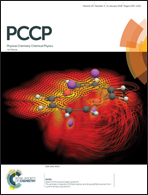Theoretical investigation of aerobic and anaerobic oxidative inactivation of the [NiFe]-hydrogenase active site†
Abstract
The extraordinary capability of [NiFe]-hydrogenases to catalyse the reversible interconversion of protons and electrons into dihydrogen (H2) has stimulated numerous experimental and theoretical studies addressing the direct utilization of these enzymes in H2 production processes. Unfortunately, the introduction of these natural H2-catalysts in biotechnological applications is limited by their inhibition under oxidising (aerobic and anaerobic) conditions. With the aim of contributing to overcome this limitation, we studied the oxidative inactivation mechanism of [NiFe]-hydrogenases by performing Density Functional Theory (DFT) calculations on a very large model of their active site in which all the amino acids forming the first and second coordination spheres of the NiFe cluster have been explicitly included. We identified an O2 molecule and two H2O molecules as sources of the two oxygen atoms that are inserted at the active site of the inactive forms of the enzyme (Ni-A and Ni-B) under aerobic and anaerobic conditions, respectively. Furthermore, our results support the experimental evidence that the Ni-A-to-Ni-B ratio strongly depends on the number of reducing equivalents available for the process and on the oxidizing conditions under which the reaction takes place.
![Graphical abstract: Theoretical investigation of aerobic and anaerobic oxidative inactivation of the [NiFe]-hydrogenase active site](/en/Image/Get?imageInfo.ImageType=GA&imageInfo.ImageIdentifier.ManuscriptID=C7CP06228A&imageInfo.ImageIdentifier.Year=2018)


 Please wait while we load your content...
Please wait while we load your content...